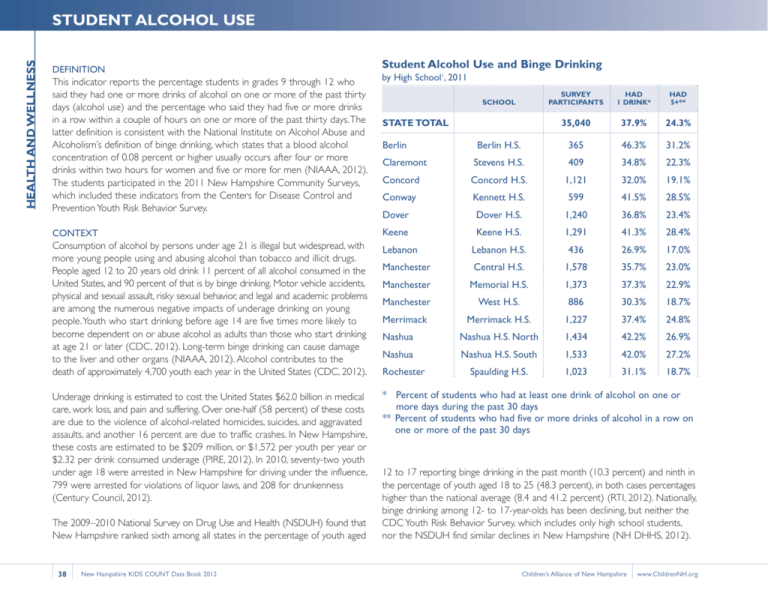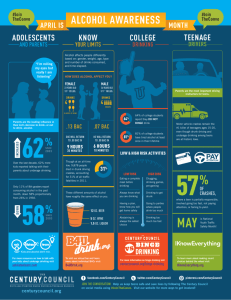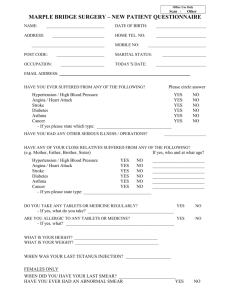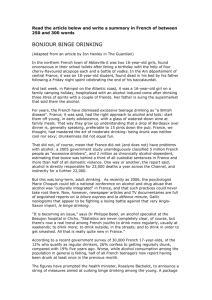
HEALTH AND WELLNESS
STUDENT ALCOHOL USE
DEFINITION
Student Alcohol Use and Binge Drinking
This indicator reports the percentage students in grades 9 through 12 who
said they had one or more drinks of alcohol on one or more of the past thirty
days (alcohol use) and the percentage who said they had five or more drinks
in a row within a couple of hours on one or more of the past thirty days. The
latter definition is consistent with the National Institute on Alcohol Abuse and
Alcoholism’s definition of binge drinking, which states that a blood alcohol
concentration of 0.08 percent or higher usually occurs after four or more
drinks within two hours for women and five or more for men (NIAAA, 2012).
The students participated in the 2011 New Hampshire Community Surveys,
which included these indicators from the Centers for Disease Control and
Prevention Youth Risk Behavior Survey.
by High School1, 2011
SURVEY
PARTICIPANTS
HAD
1 DRINK*
HAD
5+**
35,040
37.9%
24.3%
Berlin H.S.
365
46.3%
31.2%
Stevens H.S.
409
34.8%
22.3%
Concord
Concord H.S.
1,121
32.0%
19.1%
Conway
Kennett H.S.
599
41.5%
28.5%
Dover
Dover H.S.
1,240
36.8%
23.4%
CONTEXT
Keene
Keene H.S.
1,291
41.3%
28.4%
Consumption of alcohol by persons under age 21 is illegal but widespread, with
more young people using and abusing alcohol than tobacco and illicit drugs.
People aged 12 to 20 years old drink 11 percent of all alcohol consumed in the
United States, and 90 percent of that is by binge drinking. Motor vehicle accidents,
physical and sexual assault, risky sexual behavior, and legal and academic problems
are among the numerous negative impacts of underage drinking on young
people. Youth who start drinking before age 14 are five times more likely to
become dependent on or abuse alcohol as adults than those who start drinking
at age 21 or later (CDC, 2012). Long-term binge drinking can cause damage
to the liver and other organs (NIAAA, 2012). Alcohol contributes to the
death of approximately 4,700 youth each year in the United States (CDC, 2012).
Lebanon
Lebanon H.S.
436
26.9%
17.0%
Manchester
Central H.S.
1,578
35.7%
23.0%
Manchester
Memorial H.S.
1,373
37.3%
22.9%
Manchester
West H.S.
886
30.3%
18.7%
Merrimack
Merrimack H.S.
1,227
37.4%
24.8%
Nashua
Nashua H.S. North
1,434
42.2%
26.9%
Nashua
Nashua H.S. South
1,533
42.0%
27.2%
Spaulding H.S.
1,023
31.1%
18.7%
Underage drinking is estimated to cost the United States $62.0 billion in medical
care, work loss, and pain and suffering. Over one-half (58 percent) of these costs
are due to the violence of alcohol-related homicides, suicides, and aggravated
assaults, and another 16 percent are due to traffic crashes. In New Hampshire,
these costs are estimated to be $209 million, or $1,572 per youth per year or
$2.32 per drink consumed underage (PIRE, 2012). In 2010, seventy-two youth
under age 18 were arrested in New Hampshire for driving under the influence,
799 were arrested for violations of liquor laws, and 208 for drunkenness
(Century Council, 2012).
The 2009–2010 National Survey on Drug Use and Health (NSDUH) found that
New Hampshire ranked sixth among all states in the percentage of youth aged
38
New Hampshire KIDS COUNT Data Book 2012
SCHOOL
STATE TOTAL
Berlin
Claremont
Rochester
* Percent of students who had at least one drink of alcohol on one or
more days during the past 30 days
** Percent of students who had five or more drinks of alcohol in a row on
one or more of the past 30 days
12 to 17 reporting binge drinking in the past month (10.3 percent) and ninth in
the percentage of youth aged 18 to 25 (48.3 percent), in both cases percentages
higher than the national average (8.4 and 41.2 percent) (RTI, 2012). Nationally,
binge drinking among 12- to 17-year-olds has been declining, but neither the
CDC Youth Risk Behavior Survey, which includes only high school students,
nor the NSDUH find similar declines in New Hampshire (NH DHHS, 2012).
Children’s Alliance of New Hampshire
www.ChildrenNH.org
STUDENT ALCOHOL USE
SOURCE OF DATA FOR ILLUSTRATION/METHODOLOGY
by High School1, 2011
Data were obtained from the New Hampshire Department of Health and Human Services
Bureau of Drug and Alcohol Services and describe findings from the 2011 Community Surveys,
which included items from the Centers for Disease Control and Prevention Youth Risk Behavior
Survey.
STATE TOTAL
Berlin
REFERENCES
Centers for Disease Control and Prevention (2012). Fact Sheet: Underage Drinking.
> www.cdc.gov/alcohol/fact-sheets/underage-drinking.htm
Claremont | Stevens
Concord
The Century Council. Arrest data obtained from the 2010 FBI Uniform Crime Report.
> www.centurycouncil.org/state-facts/new-hampshire
Conway | Kennett
National Institute on Alcohol Abuse and Alcoholism (2012).
> www.niaaa.nih.gov/alcohol-health/overview-alcohol-consumption/moderate-binge-drinking
Dover
Keene
New Hampshire Department of Health and Human Services (2012). New Hampshire State
Epidemiological Profile of Mental, Emotional and Behavioral Health.
> www.nhcenterforexcellence.org/pdfs/State_Epi_Profile_4.23.12.pdf
Lebanon
Manchester | Central
Pacific Institute for Research and Evaluation (PIRE), Underage Drinking Enforcement Training
Center (2012). Underage Drinking Costs.
> www.udetc.org/UnderageDrinkingCosts.asp and http://www.udetc.org/factsheets/NH.pdf
Manchester | Memorial
Manchester | West
Research Triangle Institute, National Survey on Drug Use and Health (2012). State Estimates of
Substance Use.
> https://nsduhweb.rti.org/RespWeb/State_Estimates.html
Merrimack
Nashua | North
U.S Department of Health and Human Services, Substance Abuse and Mental Health Services
Administration (2011). Report to Congress on the Prevention and Reduction of Underage
Drinking.
> http://store.samhsa.gov/shin/content//SMA11-4645/SMA11-4645.pdf
Nashua | South
Rochester | Spaulding
0%
10%
20%
30%
40%
50%
NOTES
Alcohol Use
Binge Drinking
NEW HAMPSHIRE FINDINGS
In the 2011 Community Survey/Youth Risk Behavior Survey, over one-third
(38 percent) of New Hampshire high school students reported using alcohol
in the previous month. One-fourth (24 percent) of the students said they
binge drink.
www.ChildrenNH.org
Children’s Alliance of New Hampshire
1
Participation in the Community Surveys is voluntary and not all schools participate every year.
In 2011, data were not available for the high schools in our profiled cities of Derry, Laconia, and
Salem.
High schools in four cities or towns reported higher percentages of students
drinking than the state average: Berlin, Conway, Keene, and both Nashua high
schools. Those same schools plus Merrimack also reported higher percentages
of students binge drinking. Lebanon had the lowest rates for both indicators,
followed by Manchester West and Rochester.
New Hampshire KIDS COUNT Data Book 2012
39
HEALTH AND WELLNESS
Student Alcohol Use and Binge Drinking







